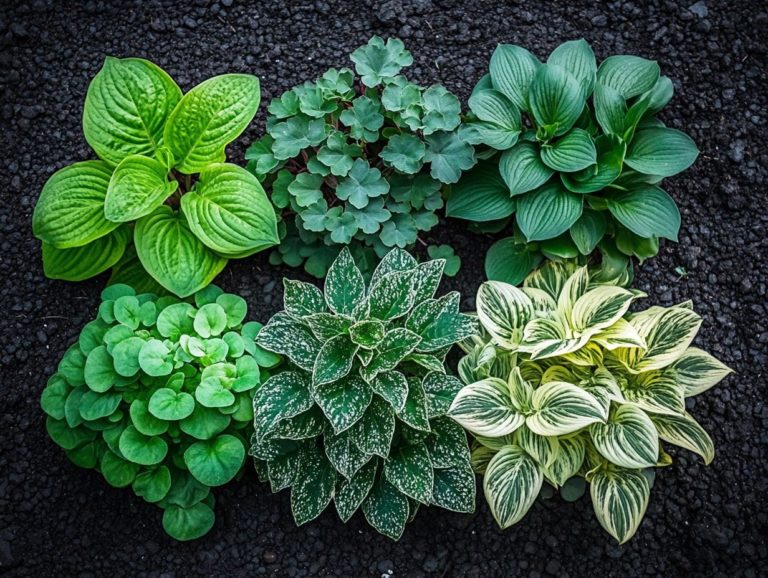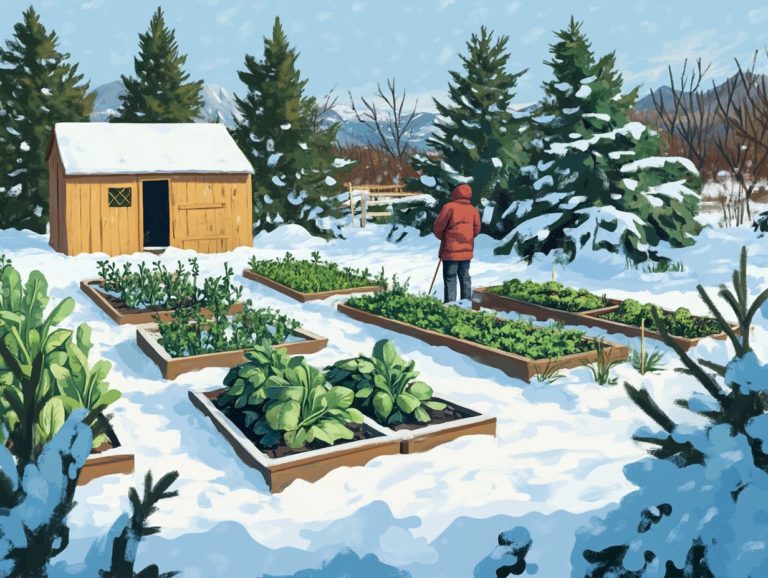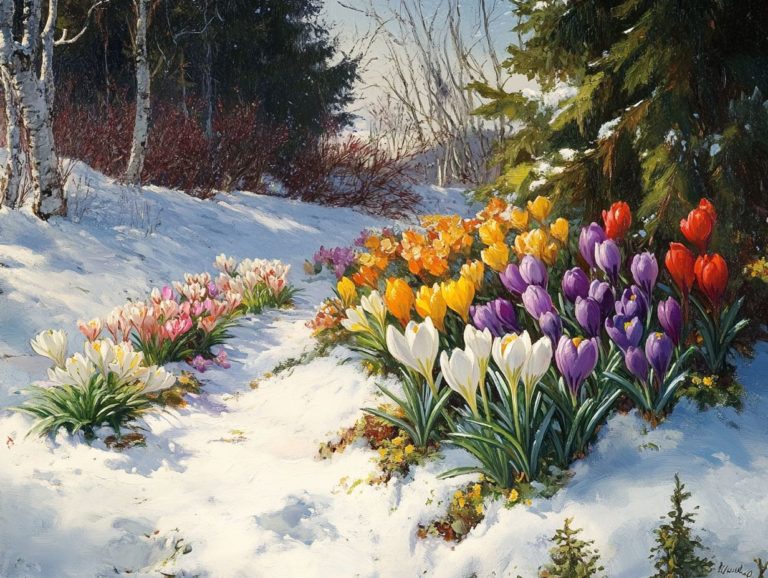Selecting Cold-Climate Plants for Urban Gardens
Urban gardening offers a distinct array of challenges, particularly in cold climates. However, selecting the right plants can transform your outdoor space into a flourishing oasis, even as temperatures drop.
This article delves into the advantages of cold-climate plants, showcasing their resilience and adaptability. You’ll learn about key factors to consider when choosing your plants, discover popular varieties that thrive in urban environments, and explore best practices for their care and maintenance.
You will discover creative ways to use your harvest in delicious meals. Get ready to transform your garden into a vibrant, productive haven!
Contents
- Key Takeaways:
- Benefits of Cold-Climate Plants
- Factors to Consider when Selecting Plants
- Types of Cold-Climate Plants
- Caring for Cold-Climate Plants
- Harvesting and Using Cold-Climate Plants
- Final Tips for Successful Urban Gardening
- Frequently Asked Questions
- What are cold-climate plants?
- Why is it important to select cold-climate plants for urban gardens?
- What types of cold-climate plants are suitable for urban gardens?
- How do I know which cold-climate plants will survive in my urban garden?
- Can cold-climate plants be grown in containers?
- Are there any special care instructions for cold-climate plants in urban gardens?
Key Takeaways:

- Select cold-climate plants for urban gardens to reap their numerous benefits, including hardiness, low maintenance, and unique flavors.
- Consider factors like climate, soil, space, and lighting before choosing cold-climate plants to ensure their successful growth.
- Care for your cold-climate plants by following best practices like proper watering, fertilizing, and pruning to ensure a bountiful harvest.
Benefits of Cold-Climate Plants
Cold-climate plants offer many advantages for gardeners. This is especially true in places like Wyoming and Southeast Wyoming, where outdoor conditions require special gardening techniques.
By embracing cold climate gardening practices, such as consulting the USDA Plant Hardiness Map to choose the most suitable seeds and incorporating tools like greenhouses or cold frames that help plants grow longer, you can significantly boost the yield of your vegetable garden.
These resilient plants not only flourish in cooler temperatures but also tend to be more resistant to pests and diseases, simplifying maintenance in the long run.
Why Choose Cold-Climate Plants for Urban Gardens?
Opting for cold-climate plants in your urban garden presents a remarkable opportunity to tailor your gardening practices to local environmental challenges. For more insights, check out understanding plant selection for cold-climate design, ultimately promoting plant resilience and sustainable growth.
These hardy plants are inherently equipped to endure the temperature fluctuations that characterize urban environments, ensuring they thrive despite the unpredictable weather patterns.
Their capacity to flourish in less-than-ideal soil conditions is a significant advantage, particularly for city gardeners who often confront various soil quality issues.
Visit your local gardening store today to find the best cold-climate plants for your garden! These retailers typically offer valuable insights into which plants will thrive in your specific locale. Engaging in community gardening initiatives further enriches your experience, allowing for the exchange of knowledge and resources while fostering a collaborative atmosphere that benefits everyone involved.
Factors to Consider when Selecting Plants
When you’re choosing plants for cold-climate gardening, it’s crucial to take several factors into account. Pay attention to your gardening zone, as well as the specific climate and soil requirements of each plant, including selecting trees for cold-climate landscaping.
Additionally, consider their unique watering needs to create the best possible conditions for optimal growth.
Climate and Soil Requirements
Understanding the climate and soil requirements of plants is essential for ensuring their health and resilience in cold-climate gardening, especially in regions that experience significant temperature fluctuations.
Different plant varieties have unique preferences regarding soil quality; some thrive in well-drained sandy soils, while others flourish in rich, loamy conditions.
Temperature swings throughout the seasons can put stress on plants, and frost can wreak havoc on sensitive species. This is where gardening zones come into play, providing crucial guidelines that help you select the right plants suited to your specific climate.
By consulting these zones, you can align your choices with species most likely to thrive, effectively safeguarding your green investments against the unpredictable whims of weather patterns.
Space and Lighting Restrictions
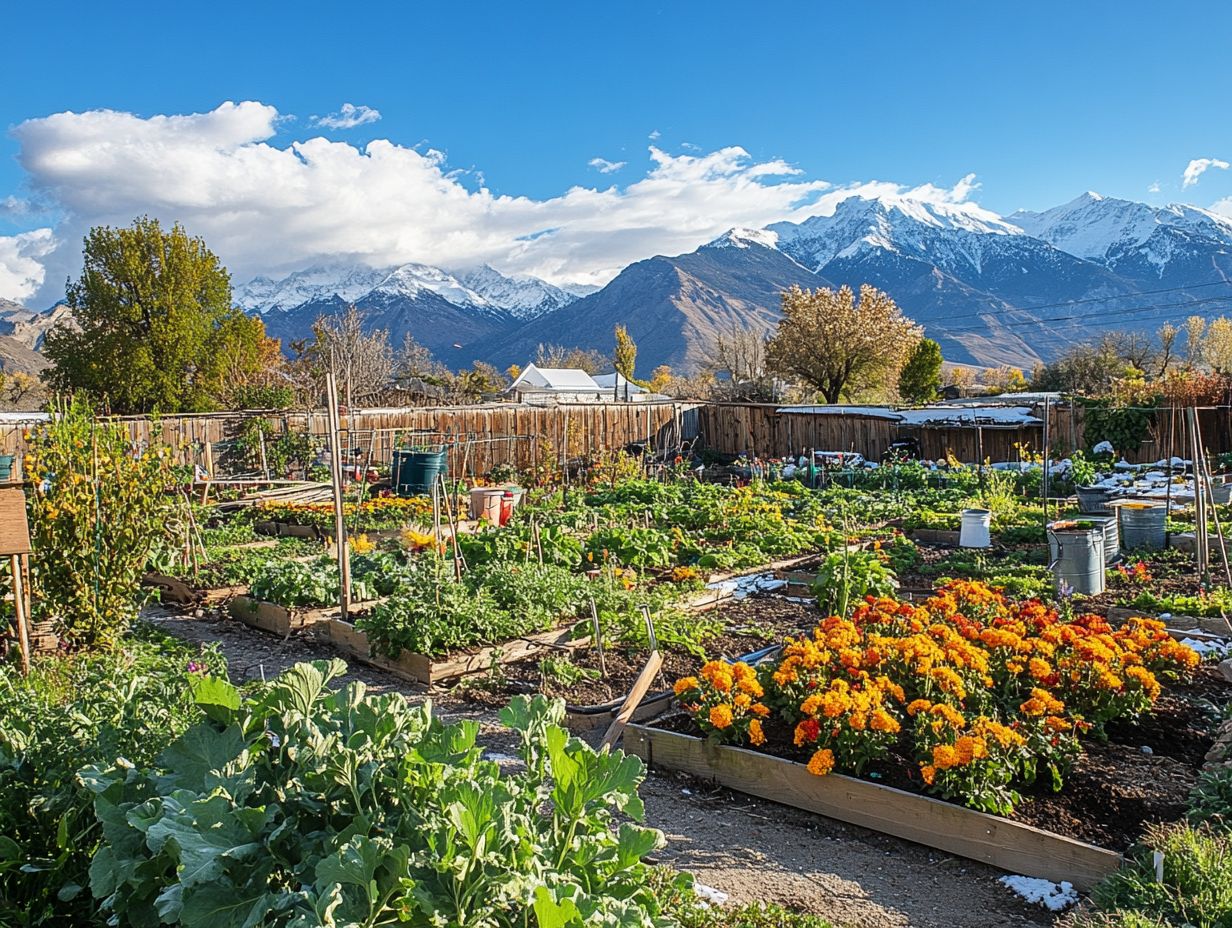
Space and lighting restrictions are vital factors for you to consider as a gardener. They directly influence your gardening layout and the selection of plants that can flourish in specific microclimates.
Understanding the available area is key, especially if you’re keen on growing cold-climate plants. It’s not just about measuring the square footage; you also need to assess the height and vertical potential of your space. This thorough evaluation will guide you in choosing the right varieties that can adapt to local conditions.
Light exposure is another critical element. Adequate sunlight is essential for photosynthesis the process by which plants make their food using sunlight and overall plant health.
You can improve light for your plants by using vertical gardening or reflective surfaces. To help your plants thrive during harsh winters, incorporate protective measures such as mulching and providing windbreaks. These tactics will support their growth, even in limited spaces.
Types of Cold-Climate Plants
Explore a fantastic range of cold-climate plants for your garden, including an array of vegetables and heirloom seeds. For optimal results, consider selecting the right containers for cold-climate plants. These selections thrive in harsh conditions, ensuring you enjoy bountiful harvests even when the temperatures drop.
Popular Varieties for Urban Gardens
Some popular plant varieties are perfect for your urban garden, especially if you’re in a cold climate. Consider selecting plants for a winter garden, focusing on sturdy vegetables and cold-resistant herbs that thrive, even if they’re technically classified as cold-sensitive.
Take kale, Brussels sprouts, and winter savory, for example. These resilient plants are bred to withstand lower temperatures, making them ideal for gardeners facing harsh winters.
Kale not only delivers a hefty nutritional boost but actually becomes sweeter after a frost. Brussels sprouts grow from a tall central stalk, producing delicious sprouts that are a delight to harvest. Meanwhile, winter savory can elevate your winter dishes with its aromatic flavor.
For the best results, visit your local gardening stores to discover these varieties. This way, you can select the plants that are perfectly tailored to your specific climate and soil conditions.
Caring for Cold-Climate Plants
Caring for cold-climate plants requires you to embrace best practices in gardening maintenance. Understanding their specific watering needs is essential to ensure they remain in optimal health.
Additionally, prepare them for the inevitable seasonal changes that come with cold climates.
Best Practices for Maintenance and Growth
Using best practices for maintenance will boost your plants’ resilience. You’ll enjoy a thriving vegetable garden, even in cold weather.
One critical area to concentrate on is improving soil moisture. You can achieve this by incorporating organic matter, such as compost or well-rotted manure. This technique retains water and boosts nutrient availability, creating a thriving environment for your plants.
Engaging in community gardening initiatives presents a remarkable opportunity for you to exchange insights and techniques with fellow gardeners. By pooling resources like mulching materials and irrigation systems, you can collaborate effectively.
This exchange of valuable knowledge about soil health and moisture retention strategies will cultivate a more sustainable and productive gardening experience for everyone involved.
Harvesting and Using Cold-Climate Plants
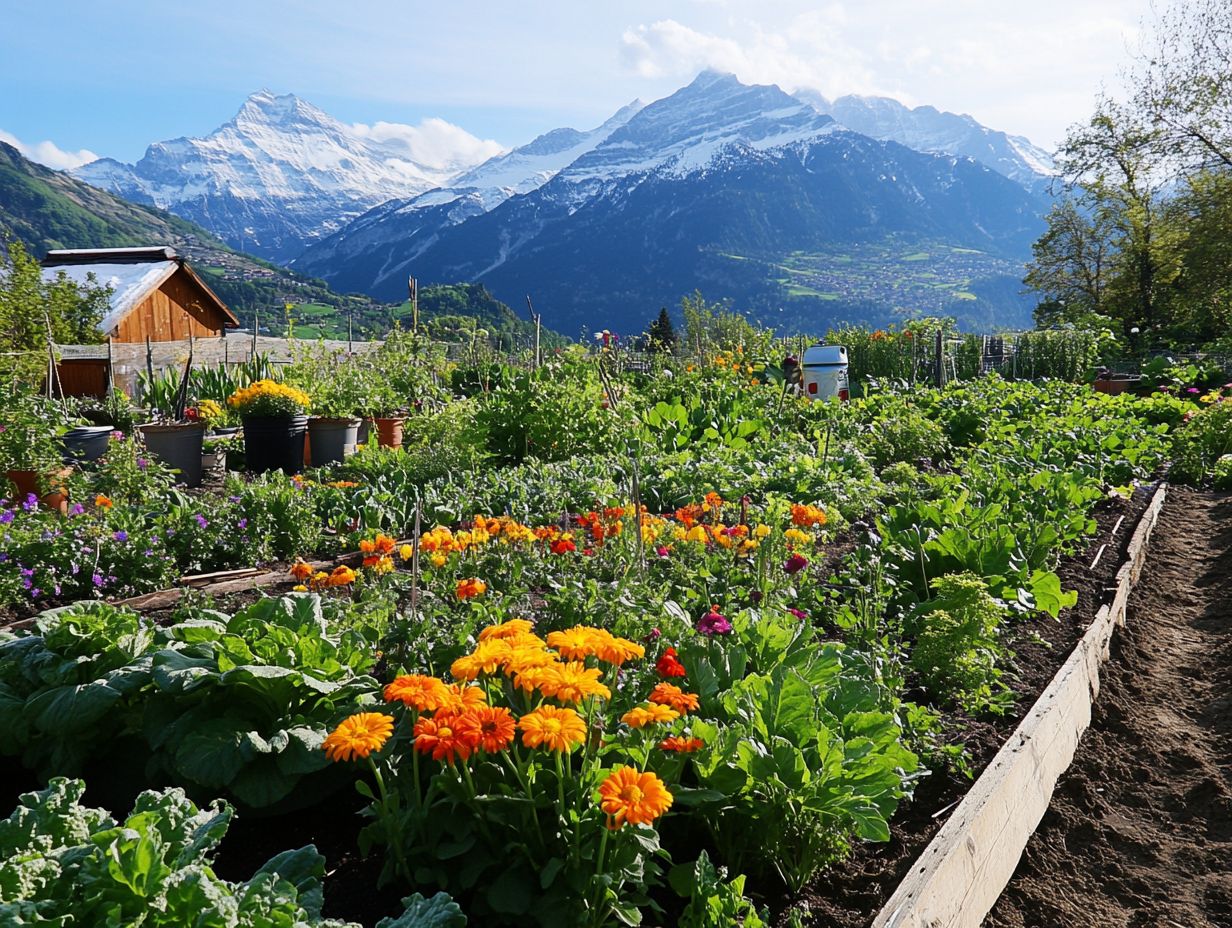
Harvesting and utilizing cold-climate plants opens up a world of creative possibilities for you in the kitchen. By incorporating fresh produce and herbs into your meals, you not only elevate your culinary experiences but also promote healthier eating habits.
The vibrant flavors and unique textures of these plants can transform your dishes, making every meal an opportunity for innovation.
Creative Ways to Incorporate Plants into Meals
Incorporating cold-climate plants into your meals can turn into a delightful culinary journey. The beauty of seasonal gardening comes alive through fresh recipes brimming with your home-grown vegetables and herbs.
By embracing the unique flavors of kale, rutabaga, and an array of root vegetables, you can elevate your dishes while celebrating the rich bounty of the harvest. Experimenting with fresh herbs like dill and parsley adds exquisite layers of flavor, transforming everyday meals into gourmet experiences that tantalize the palate.
To truly harness the potential of these seasonal treasures, maintaining a gardening diary is invaluable. Documenting growth patterns and harvest times not only aids in planning future planting cycles but also deepens your connection with the garden. This makes the journey from soil to table all the more fulfilling.
Final Tips for Successful Urban Gardening
To achieve successful urban gardening in cold climates, implement effective techniques that maximize your space and enhance your yield. By utilizing available gardening resources and tapping into community support, you can thrive even in challenging conditions.
Maximizing Space and Yield
Thoughtful planning of your gardening layout is essential for maximizing space and yield in your cold-climate urban garden. This includes the strategic use of raised beds and the incorporation of season extenders. Knowing your frost dates can help you plan your planting time effectively.
To optimize your limited space, consider techniques like vertical gardening. This approach allows vines and smaller plants to thrive upwards rather than sprawling outwards, significantly expanding your planting options.
Growing plants together can also enhance their growth and deter pests, fostering a harmonious ecosystem.
Understanding and leveraging microclimates within your garden is crucial. Identify spots that bask in more sunlight or areas sheltered from harsh winds to cultivate a vibrant and thriving space in an urban landscape.
Frequently Asked Questions
What are cold-climate plants?
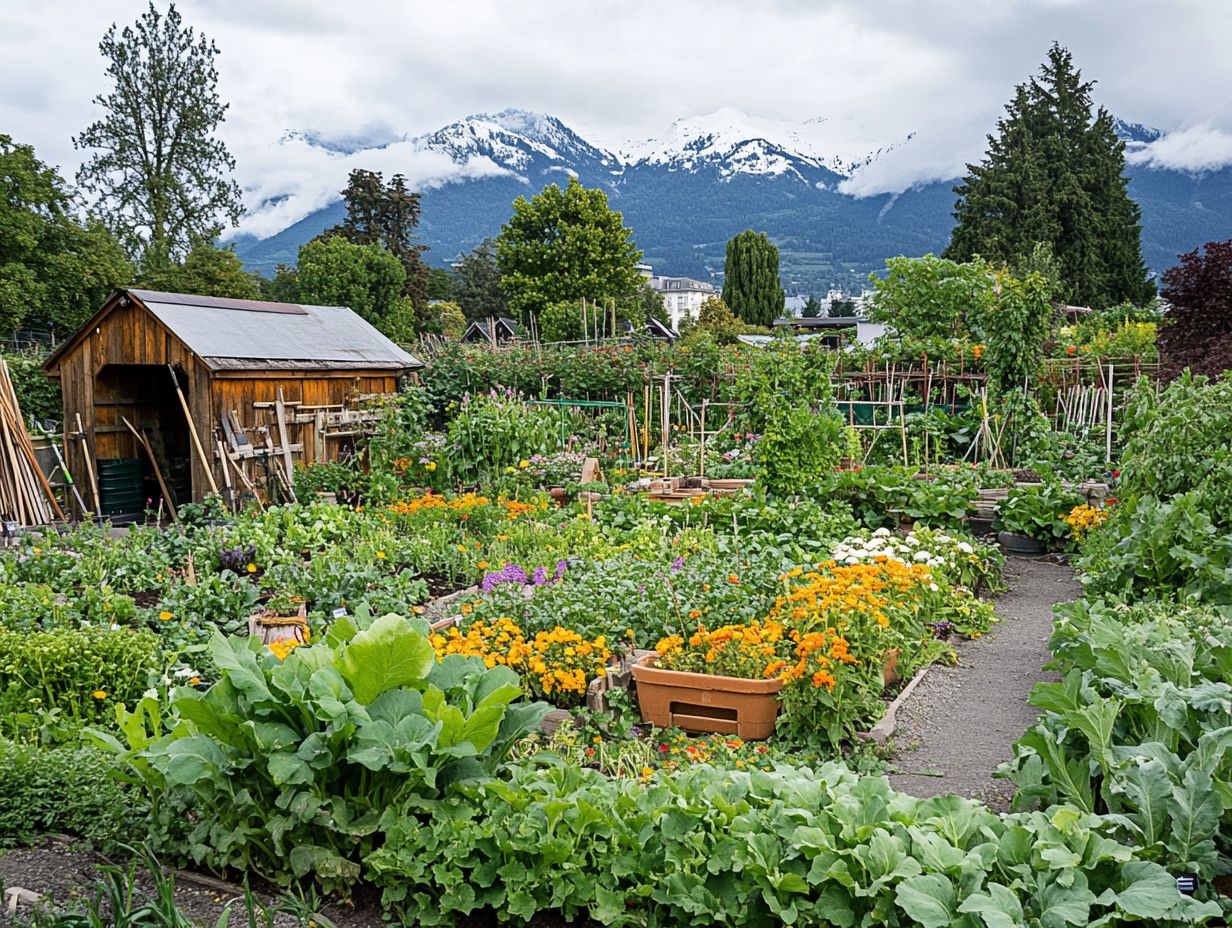
Cold-climate plants are plants that thrive in colder temperatures, typically below freezing. They are crucial for gardens in colder areas, especially when selecting plants for frost-prone areas.
Why is it important to select cold-climate plants for urban gardens?
Choosing cold-climate plants for urban gardens is essential because they can survive and thrive in harsh urban environments, which often have limited space, pollution, and extreme temperature changes. For more insights, check out this guide on selecting plants for cold climate community gardens. They require less maintenance and are more likely to flourish in these settings.
What types of cold-climate plants are suitable for urban gardens?
Many types of cold-climate plants are suitable for urban gardens, including evergreens, winter berries, conifers, and hardy shrubs. Researching and selecting plants for cold-climate rain gardens is important for your specific urban garden location.
How do I know which cold-climate plants will survive in my urban garden?
Before selecting plants for your urban garden, consider the USDA Hardiness Zone of your area. Discovering your region’s zone opens the door to choosing plants that will thrive!
Can cold-climate plants be grown in containers?
Yes, many cold-climate plants can be grown in containers, making them suitable for urban gardens with limited space. Just choose the right size container and ensure proper drainage for the plants.
Are there any special care instructions for cold-climate plants in urban gardens?
Cold-climate plants need less maintenance. However, proper care is still crucial.
They need regular watering and enough sunlight. Protect them from extreme temperatures and harsh weather.
Using organic fertilizers can help them grow well!

